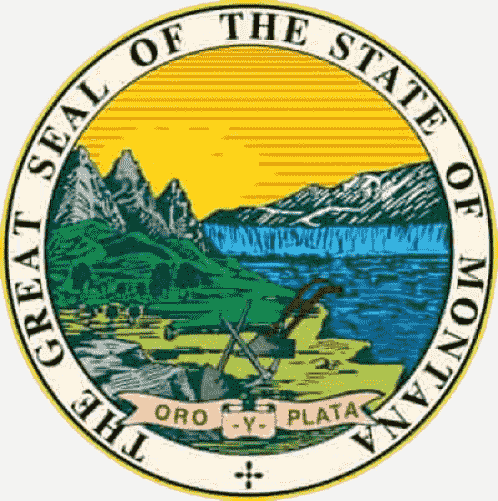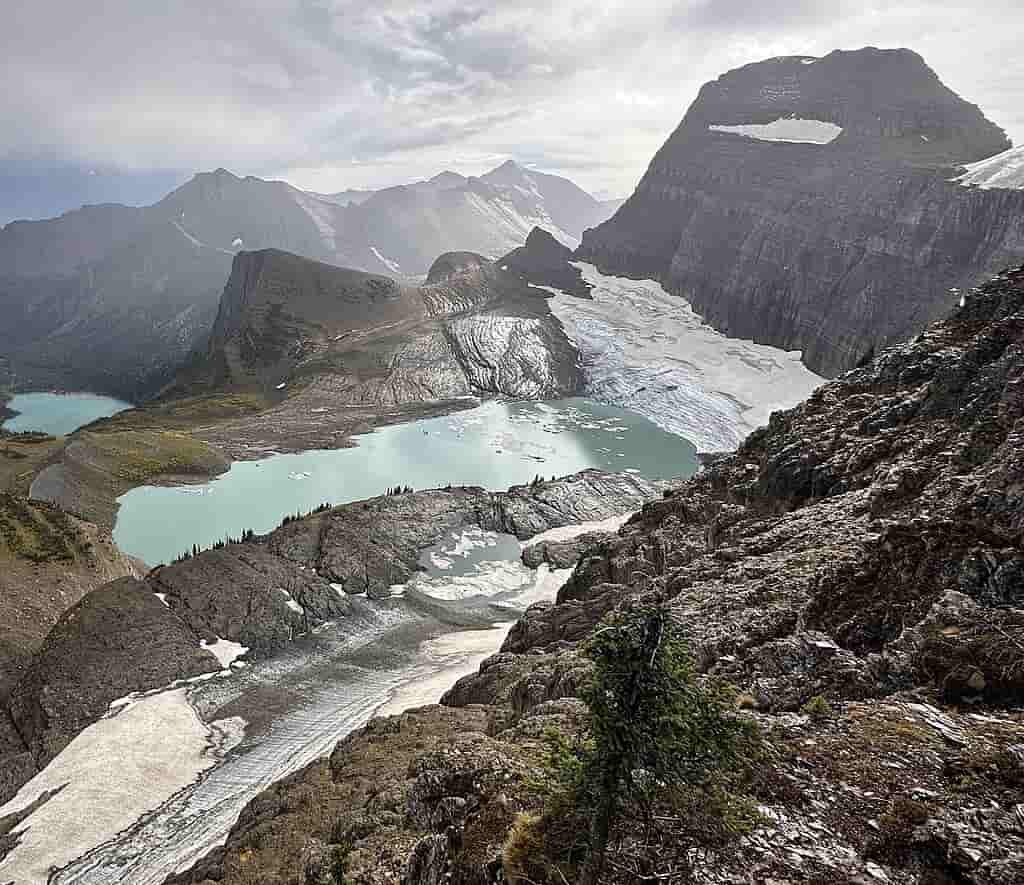 State Flag |  State Seal |
Montana is a U.S. state located in the Western United States. The state borders North Dakota and South Dakota to the east, Wyoming to the south, Idaho to the west and southwest, and Canada to the north.
- ABBREVIATION: MT
- NICKNAME: The Treasure State
- POPULATION: 1,137,233 (2024 est.)
- CAPITAL: Helena
- STATE BIRD: Western Meadowlark
- STATE FLOWER: Bitterroot
- AREA: 147,040 sq. mi.
- TIME ZONE: Mountain
- ENTERED UNION: Nov. 8, 1889
- ALTITUDE: High, 12,807 ft. Granite Peak
- CLIMATE: Cold winters, hot summers, light rain in east; Cooler summers, milder winters, more rain in the west.
As inhabitants of an area large enough to accommodate either Germany or Japan, Montanans are said to be “so accustomed to vastness that anything less than huge seems trivial to them. Here, at Three Forks on the eastern slopes of the Rockies, originates one of the great rivers of America-the mighty Missouri, which drains an area of more than 500,000 square miles before joining the Mississippi.
It was up the Missouri in the early 1800’s that the first Montanans came-fur traders and mountain men in search of beaver for the fashionable glossy hats of eastern dandies. Yet it was the Rockies which were to make Montana, for in them men of the mid-19th Century found gold and silver and, later, the copper of Butte, where lay “the richest hill on earth”. But Indians roamed the mineral area.
On June 25, 1876, George Armstrong Custer, the legendary general of the U.S. Seventh Calvary, went in search of the Sioux and their Cheyenne allies, and found death near the Little Bighorn River.

Glacier National Park, Montana
Cattle and wheat are still big industries in Montana, while lumber and mineral extraction continues to prosper. The state continues to mine gold, silver, coal, and talc and has one of the highest percentages of Craft-Breweries in the nation (ranked #3 per capita).
Tourism is also important to the economy with over ten million visitors a year, with Glacier National Park, Flathead Lake, Little Bighorn, and 3 of the 5 entrances to Yellowstone drawing tourists from around the globe.
Fun Facts:
- Many dinosaur fossils have been found in Montana, including nests with eggs and juveniles. The nests led paleontologist Jack Horner, consultant to the movie Jurassic Park, to conclude that dinosaurs exhibited family behavior.
- One of the world’s highest sports centers is located in Butte, which has an elevation of 5,549 feet.
- Montana is the only state with river systems that empty into the Gulf of Mexico, Hudson Bay, and the Pacific Ocean.
- Montana is home to the most diverse species of mammals in the U.S., there are at least 19 large mammal and 96 small mammal species.
- Montana has a tribally-controlled college on each of its Indian reservations. tribes include the Crow, Northern Cheyenne, and Blackfeet.
- The western portion of the state rises up in tall, rugged Rocky Mountain country. Many of the mountains are covered with snow for about 8 to 10 months of the year.
History:
Montana, known as “Big Sky Country” for its vast open landscapes and dramatic mountain ranges, has a long and dynamic history that begins with its Indigenous peoples and extends through exploration, frontier settlement, and statehood. The story of Montana is one of resilience, conflict, natural beauty, and cultural evolution.
For thousands of years before European contact, Montana was home to diverse Native American tribes. The Crow, Blackfeet, Assiniboine, Gros Ventre, Salish, Kootenai, and others lived in and moved through what is now Montana, relying on the land for food, shelter, and cultural identity.
The Plains tribes followed bison herds, while mountain tribes lived in more forested regions. Their societies were complex and rich in spiritual and social traditions, many of which continue today.
European interest in the region began in the early 19th century. In 1805, the Lewis and Clark Expedition passed through Montana as part of their journey to explore the Louisiana Purchase and find a route to the Pacific Ocean.
They encountered many Native nations, traded goods, and mapped the region’s rivers and mountains. Their reports attracted fur trappers and traders, who established trading posts along the Missouri River and in the Rocky Mountains.
In the mid-1800s, the United States expanded westward, and Montana’s land became part of the larger Dakota, Idaho, and Nebraska Territories. By 1864, as population and economic activity increased—particularly with the discovery of gold—Montana Territory was officially created.
Gold rushes in places like Bannack, Virginia City, and Helena drew thousands of prospectors and settlers, transforming small camps into bustling towns. Conflict with Native tribes increased as settlers encroached on traditional lands.
One of the most famous events in Montana history occurred in 1876: the Battle of the Little Bighorn, also known as Custer’s Last Stand. Led by Sitting Bull and Crazy Horse, a coalition of Lakota Sioux, Cheyenne, and Arapaho warriors defeated General George Armstrong Custer and his troops.
This victory was a powerful symbol of resistance but was followed by U.S. military retaliation and increased pressure on Native peoples to move onto reservations.
Montana continued to grow with the expansion of the Northern Pacific Railroad in the 1880s, which brought more settlers and allowed for large-scale ranching, farming, and mining. In 1889, Montana became the 41st state admitted to the Union.
Cities like Butte, known as the “Richest Hill on Earth,” became major centers for copper mining and labor activism.
In the 20th century, Montana’s economy shifted to include agriculture, tourism, and energy production. The state played a key role in both World Wars by supplying resources and soldiers. Its wide-open spaces and national parks—like Glacier National Park—have attracted millions of visitors and inspired conservation efforts.
Today, Montana remains defined by its natural beauty, cultural diversity, and frontier spirit. The history of its Native peoples, its role in westward expansion, and its enduring rural identity all contribute to the unique character of the Big Sky State.